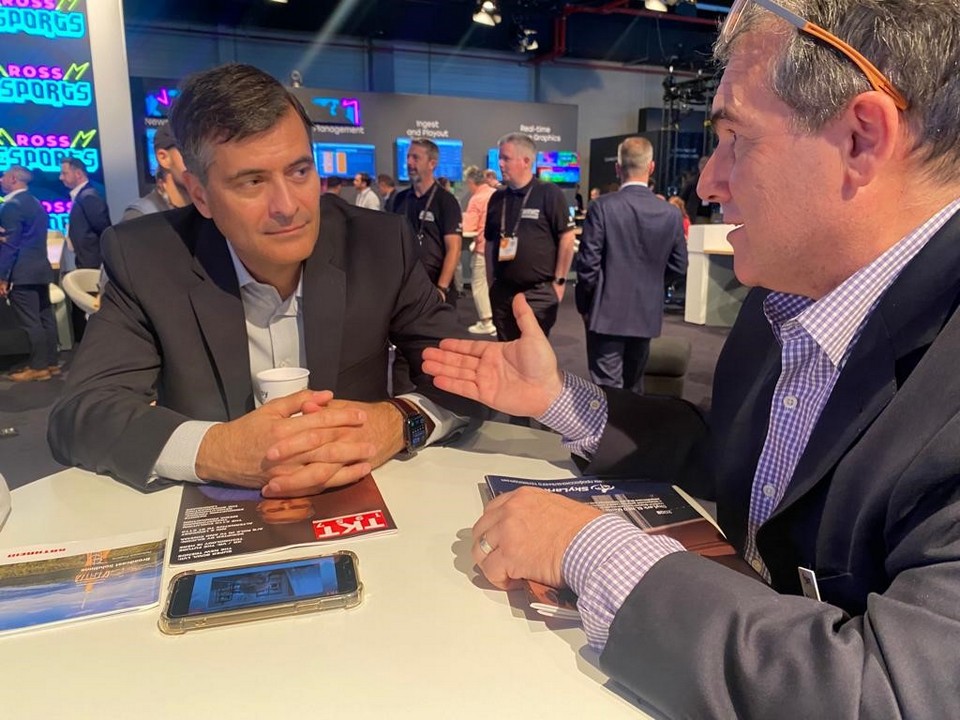
Philip Grossman and Mary Ann Seidler in the IBC 2023 report: What’s Next in Broadcasting and Cinema?
Hosts: Philip Grossman, an independent advisor providing thought leadership and solutions architecture to leaders and organizations in the film and television industry; Mary Ann Seidler, owner of First Light Media and consultant for multiCAM Systems and Telos Alliance.
Philip: You didn’t get to go, Mary, but I did.
Mary: I’m eager to hear about the highlights.
Philip: Well, it felt like a traditional IBC. The attendance was as robust as always. However, there weren’t any groundbreaking announcements. There were plenty of new product updates and enhancements, as usual. Interestingly, there was less emphasis on the cloud as a central component. Instead, the cloud was presented more as an added feature to the production environment. I spent a significant amount of time exploring camera lenses, which was a highlight for me this year. There were many new lightweight cinema primes on display.

“There was notably less buzz about 8K this year, even though it was a hot topic in the past”
Mary: I observed something similar at NAB this year. The usual innovations and ‘wow’ factor seemed to be missing. Why do you think that is?
Philip: It’s a complex issue. There are many factors at play. As we emerge from the pandemic, there’s been a significant push towards remote operations, which was a necessity. Now, organizations are trying to determine what’s practical and what isn’t. We previously saw transitions, like moving from SD to HD or from analog to digital, that spanned a decade. But in the three years before the pandemic, there was a rapid influx of technologies like IP 2110, 2022, HDR, OTT, 4K, and 8K. It was a lot for everyone to grasp. I sense that organizations have taken a step back this year to reassess. From my discussions with vendors, they’re trying to anticipate the next big trend and its direction. There was notably less buzz about 8K this year, even though it was a hot topic in the past. I believe NHK was one of the few with an 8K demo. Adobe released updates to their editing and special effects software, but they’ve been emphasizing their beta model lately. So, what’s in beta often becomes the new release. The lack of groundbreaking announcements surprised me. To answer your question, I’m not sure where the innovation has gone.

I’ve made sure the dialogue remains natural while ensuring clarity and consistency in the technical terms and expressions.
“People do still have an affinity for hardware”
Mary: One thing I’ve heard from radio broadcasters, especially from smaller stations and independent operators, is that while they find the cloud intriguing, they still prefer tangible hardware. Are you noticing a similar sentiment on the video side? Are people still asking for physical hardware?
Philip: In our realm, the situation is somewhat unique. Historically, we’ve relied on specially designed hardware with A6 chips because the performance from generic solutions wasn’t up to par. On the audio side, there’s a need for tactile interfaces that require hands-on manipulation, so hardware remains essential. Over the past five years, there’s been a significant push towards software-centric solutions. Now, off-the-shelf hardware and servers have evolved to a point where they can handle the demands, especially as manufacturers have tailored their software accordingly. We’re also seeing more integration of GPUs into hardware setups. It’s become evident that relying solely on CPUs isn’t feasible, especially now that cloud providers offer GPU-based hardware.
People do still have an affinity for hardware. One recurring question I encountered was about the cost implications of transitioning to the cloud. While media giants like ABC, NBC, Disney, CBS, Fox, and Sky have the financial muscle and global presence to make the cloud work for them, smaller entities need to weigh the pros and cons. They must determine how much of their operations should be cloud-based. I’ve never been a fan of the term “hybrid.” I lean more towards “integrated solutions,” and that sentiment resonated with some vendors I spoke to.
NAB and AES in New York
Mary: Well, next month is the NAB and AES in New York. Let’s hope we see some real innovations there.
Philip: Absolutely. I’ll be attending as well. Perhaps everyone is just saving their big reveals for that event. Or it could be that innovations are being distributed throughout the year, rather than being showcased primarily at the major conventions. However, I must admit, I have a soft spot for the grandeur of the big shows. I often find myself wishing for an extra day just to catch up with colleagues and friends. While virtual conferences have their merits, there’s something irreplaceable about spending a few days getting hands-on with the equipment, engaging with engineers, sales representatives, and the visionaries behind these companies. It’s an experience that’s invaluable to our industry.
Mary: I couldn’t agree more. Especially for audio equipment, there’s an innate desire to physically interact with the gear.
Philip: Thank you for tuning into TKT 360 Seconds. Broadcast News & Commentary for our special IBC edition. We’ll be back next Monday!
The live broadcast took place on September 25, 2023.
Learn more: Industry Titans’ Strategies Shared with TKT1957
Production – TKT1957 LLC.
Media Partner – Cine Gear Expo.
The program can be watched every Monday at 19:00 UTC+4 by clicking on any of these links:












